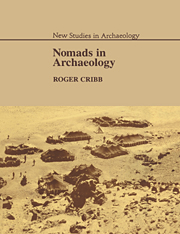Book contents
- Frontmatter
- Contents
- List of illustrations
- List of tables
- Preface
- 1 Introduction
- 2 Origins and definitions
- 3 Nomad pastoral economy
- 4 Residence, descent and territory
- 5 Nomads – the invisible culture?
- 6 Nomad architecture and domestic space
- 7 Ali's camp: a nomad household campsite
- 8 The structure and location of nomad settlements
- 9 Sariaydin Yayla
- 10 The lost world of Nemrut Daḡ
- 11 Nomad archaeology: an assessment
- 12 Towards a model of unstable settlement systems
- References
- Glossary
- Index
8 - The structure and location of nomad settlements
Published online by Cambridge University Press: 23 September 2009
- Frontmatter
- Contents
- List of illustrations
- List of tables
- Preface
- 1 Introduction
- 2 Origins and definitions
- 3 Nomad pastoral economy
- 4 Residence, descent and territory
- 5 Nomads – the invisible culture?
- 6 Nomad architecture and domestic space
- 7 Ali's camp: a nomad household campsite
- 8 The structure and location of nomad settlements
- 9 Sariaydin Yayla
- 10 The lost world of Nemrut Daḡ
- 11 Nomad archaeology: an assessment
- 12 Towards a model of unstable settlement systems
- References
- Glossary
- Index
Summary
The tribe was camping in Hassan Agha's estates near a clump of mulberry trees. They had pitched their long black tents in a neat, orderly file, and this did not escape Hassan Agha's notice. Just as if they were founding a new village, he said to himself with growing anxiety.
(From The Legend of the Thousand Bulls by Yashar Kemal)We have seen that the low archaeological profile of nomad sites cannot be attributed to the absence of material remains alone. But while nomad material culture and architecture may be comparable in variety and durability to that of more settled communities, the distribution of these remains occurs over a much wider range and in greatly reduced densities. Moreover the manner in which fluid patterns of residence group formation and fortuitous shifts in migration tracks are translated into archaeological assemblages will vary according to time and place. It is possible nevertheless to make some broad generalizations about what sets a nomad settlement system apart from a sedentary one and how nomad campsites differ fundamentally in their internal structure from sedentary communities.
Nomad settlement systems
The term ‘settlement system’ has been carefully chosen as against ‘settlement pattern’ in order to distinguish a system of controlling variables (Flannery 1976b, pp.162–3) from a physical pattern of settlement (Chang (ed.) 1968; Trigger 1968). The latter approach applied to nomad camps would yield a picture of segmented settlement units located in relation to each other according to patterns of kinship, tribal affiliation and economic cooperation.
- Type
- Chapter
- Information
- Nomads in Archaeology , pp. 133 - 161Publisher: Cambridge University PressPrint publication year: 1991

